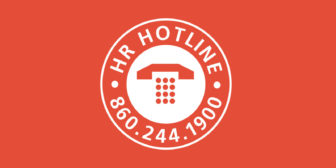How to Respond If an Employee Tests Positive for COVID-19
12.03.2020

HR & Safety
The following steps for responding when an employee tests positive for the coronavirus are based on the U.S. Centers for Disease Control and Prevention’s Interim Guidance for Businesses and Employees.

Immediate Response
- Employees who have COVID-19 symptoms (i.e., fever, cough, or shortness of breath) should notify their supervisor and stay home.
- Employees who appear to have symptoms upon arrival at work or who become sick during the day should immediately be separated from other employees, customers, vendors, and visitors, and sent home.
- Sick employees should follow CDC-recommended steps. Employees should not return to work until the criteria to discontinue home isolation are met, in consultation with healthcare providers and state and local health departments.
- Employees who are well but who have a sick family member at home with COVID-19 should notify their supervisor and follow CDC recommended precautions.

Protect Other Employees
- If an employee is confirmed to have COVID-19, employers should inform fellow employees of their possible exposure but maintain confidentiality as required by the Americans with Disabilities Act.
- The CDC defines “close contact” as “someone who was within six feet of an infected person for a cumulative total of 15 minutes or more over a 24-hour period starting from two days before illness onset (or, for asymptomatic patients, two days prior to test specimen collection) until the time the patient is isolated.”
- Fellow employees should self-monitor for symptoms.
- Identify where the infected employee worked, as well as those individuals—including colleagues, customers, visitors, and vendors—the infected employee came into contact with during the 14 days prior to testing positive or first displaying symptoms.
- Employers should notify affected customers, visitors, and vendors and instruct those employees who came into contact with the sick employee within the 14 day period to go home and self-isolate for 14 days, working remotely if possible.
- The CDC issued new guidelines July 22 recommending that affected employees can return to work and resume other normal activities provided they meet each of these criteria: at least 10 days have passed since they first had symptoms, or 10 days have passed since an initial positive test if they had no symptoms; they have been fever-free for 24 hours without the aid of fever-reducing medication, such as acetaminophen or ibuprofen; all other COVID-related symptoms continue to improve.
- The July 22 recommendations apply to individuals who had mild to normal cases of the virus. Those with severe to critical cases may remain infectious for up to 20 days after symptoms first begin.
- The CDC also released new quarantine guidelines Dec. 1. While the agency still recommends a 14-day quarantine “as the best way to reduce the risk of spreading COVID-19,” it now provides alternatives for those exposed to someone with the virus—if individuals do not develop symptoms, they need only quarantine for 10 days. If they test negative, that period can be reduced to just one week.
- OSHA recordkeeping requirements mandate covered employers record certain work-related injuries and illnesses on their OSHA 300 log. OSHA released new guidance May 19 that employers are responsible for recording a COVID-19 case if it is confirmed as a COVID-19 illness; is work-related; and involves one or more of the general recording criteria, such as medical treatment beyond first aid or days away from work.

Workplace Environment
- Based on the size of the workplace and the potential breadth of exposure to coronavirus, the employer should consider closing immediately, coordinating with employees to work remotely if possible.
- Perform enhanced cleaning and disinfection after persons suspected or confirmed to have COVID-19 have been in your facility, following CDC cleaning and disinfection recommendations.
- Employers should develop policies for worker protection and provide training to all cleaning staff on site prior to providing cleaning tasks. Training should include when to use personal protective equipment, what PPE is necessary, how to properly wear, use, and take off PPE, and how to properly dispose of PPE.
- Employers must ensure workers are trained on the hazards of the cleaning chemicals used in the workplace in accordance with appropriate OSHA standards.
- Collaborate with local and state health departments to ensure appropriate protocols and guidelines, such as updated/additional guidance for cleaning and disinfection, are followed, including for identification of new potential cases of COVID-19.

Sick Leave, FMLA
- From April 1, 2020 through December 31, 2020, federal law mandates that employers with less than 500 employees provide workers with paid sick leave or paid family and medical leave for specified reasons related to COVID-19.
- Employers qualify for dollar-for-dollar reimbursement through tax credits for all qualifying wages paid under the federal paid sick leave and paid FMLA mandates.
- Smaller employers with fewer than 50 employees may qualify for exemption from the federal requirement to provide leave due to school closings or child care unavailability if the leave requirements would jeopardize the viability of the business as a going concern.
- Connecticut law requires that employers of 50 more workers provide up to 40 hours of paid sick leave to each of their in-state, full or part-time service workers. Manufacturers, nationally chartered nonprofit organizations that provide recreation, child care, and education services, and employers with fewer than 50 workers are exempt.
HR problems? Email or call Diane Mokriski at the HR Hotline (860.244.1900) | @HRHotline
RELATED
EXPLORE BY CATEGORY
Stay Connected with CBIA News Digests
The latest news and information delivered directly to your inbox.



